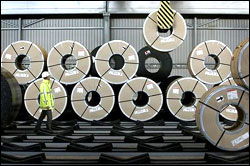 MIT researchers have found a new method through which steel-making - one of the world's leading industrial source of greenhouse gases -- can be made completely 'green' and carbon-free.
MIT researchers have found a new method through which steel-making - one of the world's leading industrial source of greenhouse gases -- can be made completely 'green' and carbon-free.
Steel-making results in vast amounts of carbon, and belching flame and smoke. But a new process developed by Massachusetts Institute of Technology researchers could change all that.
The resulting steel should be of higher purity, and eventually, once the process is scaled up, cheaper.
Production of a ton of steel generates almost two tons of CO2 emissions, according to steel industry figures, accounting for as much as 5 per cent of the world's total greenhouse-gas emissions, researchers said.
The industry has met little success in its search for carbon-free methods of manufacturing steel.
Donald Sadoway, Professor of Materials Chemistry at MIT and senior author of a new study, found that a process called molten oxide electrolysis could use iron oxide from the lunar soil to make oxygen in abundance, with no special chemistry.
He tested the process using lunar-like soil from Meteor Crater in Arizona — which contains iron oxide from an asteroid impact thousands of years ago —
The MIT team identified an inexpensive metal alloy that can replace the iridium anode in molten oxide electrolysis.
It wasn't an easy problem to solve, Sadoway said, because a vat of molten iron oxide, which must be kept at about 1600 degrees Celsius, "is a really challenging environment.
The melt is extremely aggressive. Oxygen is quick to attack the metal."
Antoine Allanore, Assistant Professor of Metallurgy at MIT said progress has been slow both because experiments are difficult at these high temperatures, and also because the relevant expertise tends to be scattered across disciplines.
The problem was solved using an alloy that naturally forms a thin film of metallic oxide on its surface: thick enough to prevent further attack by oxygen, but thin enough for electric current to flow freely through it.
The answer turned out to be an alloy of chromium and iron -- constituents that are ‘abundant and cheap,’ Sadoway said.
In addition to producing no emissions other than pure oxygen, the process lends itself to smaller-scale factories.
Apart from eliminating the emissions, the process yields metal of exceptional purity, Sadoway said.
The study was published in the journal Nature.








